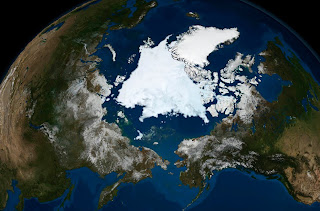
This image taken by NASA's Aqua satellite in 2008 shows the state of Arctic sea ice. Mankind's immense pressure on the planet is causing the fastest extinction of species in millions of years and is rapidly heating up the planet, threatening more extreme weather.
According to projections by the United Nations, the world population has reached 7 billion and continues to grow rapidly. While more people are living longer and healthier lives, gaps are widening between the rich and the poor in some nations and tens of millions of people are vulnerable to food and water shortages. There is, of course, the issue of the impact of that sheer number on the environment, including pollution, waste disposal, use of natural resources and food production. This post focuses on wheat and the effect of our numbers on the environment. Wheat is the most important cereal in the world and along with rice and corn accounts for about 73 percent of all cereal production. It isn't surprising that 7 billion people have a lasting impact on our world's natural resources and the environment in which we live.

A male polar bear carries the head of a polar bear cub it killed and cannibalized in an area about 300 km (186 miles) north of the Canadian town of Churchill in 2009. Food supplies for polar bears are being affected by rising temperatures and melting ice.

One of the world's breadbaskets lies in the prairies of Canada. This stalk, near Lethbridge, Alberta, helps form the foundation for the most important food product in the world: cereal grains.

Massive grain elevators hold wheat before it is transferred onto railway cars in Carseland, Alberta.

Grain inspector Jim Dolan inspects wheat from the Canadian prairies at the Pioneer grain elevator in Carseland, Alberta. For decades, the world's focus has been more on distributing food aid, including excess grains, to poor nations. Over the last few years, that focus has shifted toward better positioning poor farmers to feed themselves, according to Reuters.

A display case in the quality control room at the Alliance Grain Terminal in Vancouver, British Columbia. With the stumbling economy hindering government efforts to boost production and distribution, such private groups as the Bill and Melinda Gates Foundation and the Rockefeller Foundation are becoming more involved in agricultural research and development.

Rail cars loaded with Canadian wheat travel through the Rocky Mountains on the Canadian Pacific railway line near Banff, Alberta.

Wheat is harvested in Alberta this fall. The United Nations predicts the world's population will grow to about 9 billion by 2050. With no increase in arable land expected, a collection of private foundations, government agencies, and the United Nations are seeking ways to boost production in such crops as wheat.

A farmer takes water from a dying pond to irrigate his vegetable field on the outskirts of Yingtan in China.

A worker removes dead fish from a lake in Wuhan, central China's Hubei province, in 2007. Mankind's immense pressure on the planet is causing the fastest extinction of species in millions of years and is rapidly heating up the planet, threatening more extreme weather, according to scientists.

A Hindu devotee wraps a piece of clothing around himself after a ritual dip in the polluted Yamuna river in New Delhi in 2010. The United Nations warns that the problems of pollution, deforestation, and climate change are expected to worsen as the world's population climbs.

A boy swims in the polluted waters of Manila Bay in the Philippines in 2010. "Manila Bay has become a huge floating dump for the whole of metro Manila,'' said one Greenpeace worker.

A cargo ship plies the Strait of Georgia off Vancouver, British Columbia. Grain exports from Canada and the United States are pieces of the puzzle on how the world is going to feed its growing population. "We are talking about adding 2.6 billion people between now and 2050. That is two Chinas," Robert Thompson, former director of rural development for the World Bank, told Reuters. "We have to raise productivity. I think we can do it all if we invest enough in research. But at the moment we aren't."

Pigeons and dust cloud a street in Kuwait City in 2008. The world's mean temperatures continue to rise, say UN scientists

Two youths frolic at a beach in Qingdao, Shandong province, in China. The resort city has been the site of large algae blooms.

A garbage collector carries a sack as he walks atop a massive pile of garbage at the Bloemendhal dump in central Colombo in 2009.

Steam billows from the cooling towers of Vattenfall's Jaenschwalde brown coal power station on a lake near Cottbus, eastern Germany in 2009.

Oil is burned off the surface of the water near the source of the Deepwater Horizon spill in the Gulf of Mexico off the coast of Louisiana last summer. The US government estimates that 206 million gallons of oil were released by BP's well a mile beneath the sea. Tens of billions of dollars have been spent or committed by BP on cleaning up the devastation and compensating victims.

A laborer takes a break from his work at a brick factory at Togga village on the outskirts of the northern Indian city of Chandigarh in 2009.

The Haibowan coal-fired power plant on the outskirts of Wuhai in China's northern Inner Mongolia region in 2009.

A man works at the site of a rare earth metals mine at Nancheng county, Jiangxi province in 2010.






















Tiada ulasan:
Catat Ulasan